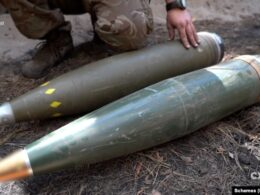Although Russian forces have increased pressure on the eastern front in Ukraine, a Russian breakthrough at the operational level is unlikely due to a lack of artillery ammunition and other factors, according to the Defense Intelligence Center of Estonia.
According to Estonian intelligence, the Russian forces have increased pressure in two directions of the eastern front, namely the Avdiivka-Mariinka and Kupiansk-Lyman axes. The intensity of Russian offensive operations will continue in the coming days or weeks, Colonel Ants Kiviselg, commander of the Defense Intelligence Center of Estonia, said at a press conference on 20 October.
"Probably the main goal of the Russian forces at the moment is to regain the initiative by tying up Ukrainian armed units, depriving them of their offensive potential and taking advantage of the window of opportunity that is currently available for a mechanized attack before the mud season in Ukraine," Ants Kiviselg said.
According to Kiviselg, Russia faces problems that can make it hard to maintain a high-intensity war against Ukraine. A lack of artillery ammunition is one of such problems. There are only four million artillery shells left in Russia, with which a low-intensity war can be waged for another year, Kiviselg reported. At the same time, the delivery of artillery shells from North Korea shows that Russia plans to continue the war of attrition against Ukraine at any cost.
Military analysis: Mud season could aid Ukraine’s offensive on southern front
The commander of the Defense Intelligence Center of Estonia confirmed information about the supply of ammunition to Russia from North Korea. According to Estonia's intelligence, up to 1,000 standard shipping containers with cargo have already arrived from Russia's Far East in the city of Tikhoretsk in the Krasnodar Krai (western Russia).
Given that one such container can hold 300-350 shells for 152-mm artillery systems, it can be assumed that Russia has received 300-350 thousand shells from North Korea. The average daily firing rate of Russian artillery is around 10,000. Thus, this amount of North Korean ammunition would be enough for about a month of intensive combat in Ukraine, according to Estonia's intelligence.
The commander of the Defense Intelligence Center of Estonia also pointed out that the Russian military command takes Ukrainian raids in the occupied Kherson Oblast (southern Ukraine) seriously. According to Ants Kiviselg, Russia takes active measures to prevent Ukrainian forces from establishing and widening a bridgehead on the eastern bank of the Dnipro River in the occupied part of the Kherson Oblast.
ISW: Ukrainian actions on the east bank of Kherson Oblast larger than before
According to Estonian intelligence, there is evidence of additional deployment of Russian forces in this area, which may indicate that the Russians feel threatened by Ukrainian operations on the eastern bank of the Dnipro River.
Ants Kiviselg said the Kakhovka dam destruction in early June 2023 and the flooding in the Kherson Oblast along the banks of the Dnipro River allowed Russian military command to deploy troops from this direction to the Zaporizhzhia Oblast to strengthen the defenses there against the counteroffensive of the Ukrainian Armed Forces. Currently, the terrain in the Kherson direction has dried up significantly, and the Dnipro River has become narrower, creating better conditions for a possible river-crossing operation, according to Estonia's intelligence.
The purpose of the Ukrainian Armed Forces' raids across the Dnipro River in the Kherson Oblast is likely to constrain Russian troops. According to the latest information that Estonian intelligence has, the Ukrainian raids on the eastern bank of the occupied Kherson Oblast pin a significant amount of Russian forces in this operational zone.
Related:
- Frontline report: Russia's Avdiivka offensive "not worth the losses," a Russian troop said
- Weekly Frontline Update: Russian debacle in Avdiivka




